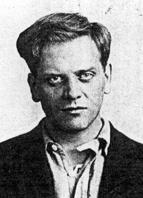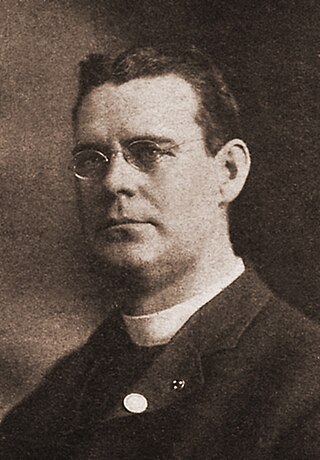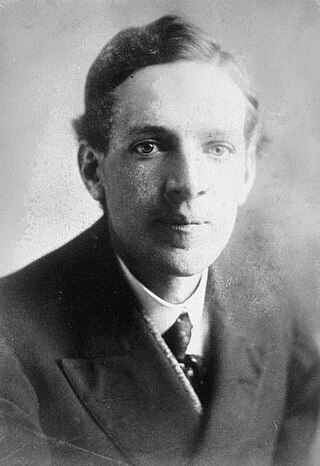
Syndicalism is a revolutionary current within the labor movement that seeks to unionize workers according to industry and advance their demands through strikes with the eventual goal of gaining control over the means of production and the economy at large. Developed in French labor unions during the late 19th century, syndicalist movements were most predominant amongst the socialist movement during the interwar period which preceded the outbreak of World War II.

The Industrial Workers of the World (IWW), nicknamed "Wobblies", is an international labor union founded in Chicago in 1905. The nickname's origin is uncertain. Its ideology combines general unionism with industrial unionism, as it is a general union, subdivided between the various industries which employ its members. The philosophy and tactics of the IWW are described as "revolutionary industrial unionism", with ties to socialist, syndicalist, and anarchist labor movements.

Ralph Hosea Chaplin (1887–1961) was an American writer, artist and labor activist.

Thomas Joseph Hagerty was an American Roman Catholic priest and trade union activist. Hagerty is remembered as one of the founding members of the Industrial Workers of the World (IWW), as author of the influential Preamble to the Constitution of the IWW, and as the creator of "Hagerty's Wheel", a frequently reproduced illustration depicting the interrelation of the IWW's constituent industrial unions.
Industrial unionism is a trade union organising method through which all workers in the same industry are organized into the same union, regardless of skill or trade, thus giving workers in one industry, or in all industries, more leverage in bargaining and in strike situations.

The Industrial Worker, "the voice of revolutionary industrial unionism", is the magazine of the Industrial Workers of the World (IWW). It is currently released quarterly. The publication is printed and edited by union labor, and is frequently distributed at radical bookstores, demonstrations, strikes and labor rallies. It covers industrial conditions, strikes, workplace organizing experiences, and features on labor history. It used to be released as a newspaper.

Edmondo Rossoni was a revolutionary syndicalist leader and an Italian fascist politician who became involved in the fascist syndicalist movement during Benito Mussolini's regime.
Free speech fights are struggles over free speech, and especially those struggles which involved the Industrial Workers of the World and their attempts to gain awareness for labor issues by organizing workers and urging them to use their collective voice. During the World War I period in the United States, the IWW members, engaged in free speech fights over labor issues which were closely connected to the developing industrial world as well as the Socialist Party. The Wobblies, along with other radical groups, were often met with opposition from local governments and especially business leaders, in their free speech fights.

Charlotte Anita Whitney, best known as "Anita Whitney", was an American women's rights activist, political activist, suffragist, and early Communist Labor Party of America and Communist Party USA organizer in California.
The Industrial Pioneer was a monthly publication of the Industrial Workers of the World (IWW) from 1921 to 1926. It was published in Chicago by the general executive board of the IWW, under various editors. The precursor of the Industrial Pioneer was the The One Big Union Monthly.
The Industrial Workers of the World (IWW) is a union of wage workers which was formed in Chicago in 1905. The IWW experienced a number of divisions and splits during its early history.

The California Criminal Syndicalism Act was a law of California in 1919 under Governor William Stephens criminalizing syndicalism. It was enacted on April 30, 1919, and repealed in 1991.
Criminal syndicalism has been defined as a doctrine of criminal acts for political, industrial, and social change. These criminal acts include advocation of crime, sabotage, violence, and other unlawful methods of terrorism. Criminal syndicalism laws were enacted to oppose economic radicalism.
A general strike refers to a strike action in which participants cease all economic activity, such as working, to strengthen the bargaining position of a trade union or achieve a common social or political goal. They are organised by large coalitions of political, social, and labour organizations and may also include rallies, marches, boycotts, civil disobedience, non-payment of taxes, and other forms of direct or indirect action. Additionally, general strikes might exclude care workers, such as teachers, doctors, and nurses.
Paul Frederick Brissenden was an American labor historian, who wrote on various labor issues in the first half of the 20th century. He is perhaps best known for his 1919 work on the Industrial Workers of the World, entitled The IWW: a Study of American Syndicalism.
The 1923 San Pedro maritime strike was, at the time, the biggest challenge to the dominance of the open shop culture of Los Angeles, California until the rise of the Congress of Industrial Organizations in the 1930s.

Carl Paivio was a Finnish American labor activist and anarchist. He became known in 1919 during the First Red Scare as Paivio and his fellow anarchist Gust Alonen were convicted of "criminal anarchy" for writing in a radical newspaper. Paivio and Alonen were the first activists convicted in the State of New York for violating the Criminal Anarchy law, although it was passed already in 1902 right after the assassination of the president William McKinley.

The 1917 Sacramento Governor's Mansion bombing took place in the middle of the night on December 17, 1917 when 20 sticks of dynamite exploded near the rear porch of the Governor's Mansion just blocks from the Capitol Building.
The Goldfield, Nevada labor troubles of 1906–1907 were a series of strikes and a lockout which pitted gold miners and other laborers, represented by the Western Federation of Miners (WFM) and the Industrial Workers of the World (IWW), against mine owners and businessmen.

Liberty Hill site in San Pedro, Los Angeles, California was the site of the 1923 strike by the Marine Transport Workers Industrial Union 510 a part of the Industrial Workers of the World (IWW). The strike was called to draw attention to the worker's low wages and poor working conditions. It was also to draw attention to some union activists that had been arrested and lockup for violating the California Criminal Syndicalism Act passed on April 30, 1919 by Governor William Stephens, which criminalized syndicalism. The strike tied up 90 ships in Port of Los Angeles San Pedro. The Liberty Hill site was designated a California Historic Landmark on March 3, 1997.










